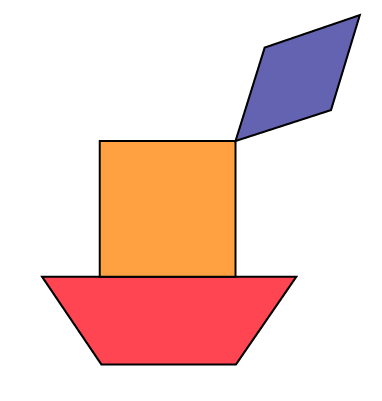C1.3 Determine pattern rules and use them to extend patterns, make and justify predictions, and identify missing elements in patterns represented with shapes and numbers.
Activity 1: More Patterns!
Summary
In this activity, students reproduce and extend repeating patterns using manipulatives.
Materials
- variety of patterns created on paper or cardboard strips of about 30 cm × 5 cm
- manipulatives (enough to create each pattern)
Directions
On strips of paper (for example, cash register paper) or cardboard, prepare patterns using materials (pasta, buttons, geometric shapes, etc.) that students are familiar with. Ensure that the pattern is repeated three times. Objects can be glued to the strips or drawn. Provide each student or team with a pattern and the materials to repeat and extend it.
Here are some examples of possible patterns:

Source: translated from Guide d’enseignement efficace des mathématiques de la maternelle à la 3e année, Modélisation et algèbre, Fascicule 1, Régularités et relations, p. 86.
Ask students to reproduce the pattern under the sample using concrete materials and then extend it. Have them work on the floor, as this will make it easier for them to extend the pattern.
Observe how the students reproduce the pattern and extend it (for example, one-to-one correspondence, one core at a time, explanation of the core).
Observe students and ask them questions as needed such as:
- Describe your pattern.
- What is the next term in your pattern? How do you know?
- Show me the first pattern core.
- Why do you say it is the first element of the pattern? the last element?
- What is the core of the pattern?
When students have reproduced and extended a pattern, ask them to exchange their pattern card and materials to construct new patterns.
Circulate around the classroom and ask students to compare the patterns, explaining the similarities and differences between the reproduced and extended patterns (for example, attribute, number of elements in the pattern).
Note: This activity lends itself well to the various stories or topics studied throughout the year. For example, the three kinds of houses in The Three Little Pigs can be constructed and used to create a pattern.
Source: translated from Guide d’enseignement efficace des mathématiques de la maternelle à la 3e année, Modélisation et algèbre, Fascicule 1, Régularités et relations, p. 86-87.
Activity 2: Steamboat (Extend, Predict and Justify)
Ask students to build a steamboat using a red trapezoid and an orange square. Have them add a blue diamond to represent the steam.

How many pattern blocks are needed to build 10 steamboats?
When solving this problem, students discover the relationship between the number of pattern blocks that are needed to build them. Have students solve this problem by creating the steamboats and filing in a table of values. After the first three steamboats are recorded, ask students if they see a pattern rule that they can use to determine the number of pattern blocks for 10 steamboats.
Source: translated from Guide d’enseignement efficace des mathématiques de la maternelle à la 3e année, Modélisation et algèbre, Fascicule 1, Régularités et relations, p. 48.
Activity 3: Guess the Next Step (Predict and Justify)
Prepare different decks of number cards that represent the pattern cores (for example, pattern of even numbers, odd numbers; pattern of numbers that are multiples of 5, 10). Place the number cards in ascending or descending order.
Line up the cards of a deck, face up, in front of a small group of students.
Turn over the first card in the deck that is the starting of the pattern. Ask students to predict the next number. For example, the card turned over has the number 40 on it. Students can predict that on the next card there will be the number 50 (+10 pattern rule), 60 (+20 pattern rule), 51 (+11 pattern rule), 30 (-10 pattern rule), etc.
Turn over the second card and invite students to describe what the pattern might be. Again, ask students to predict the next couple of cards. Turn the cards to verify the predictions.
Once all the cards have been turned over, ask students to observe if there is another pattern rule; for example, depending on the pattern revealed, it is possible that there is a pattern in the increase or decrease of the digits of the tens and the ones.
Source: translated from Guide d’enseignement efficace des mathématiques de la maternelle à la 3e année, Modélisation et algèbre, Fascicule 1, Régularités et relations, p. 65-66.
Activity 4: Petey, the Pig
Summary
In this activity, students are asked to solve a problem by discovering the number pattern rule.
Materials
- Manipulatives
- number grids, number lines, and calendars (enough for the class)
Directions
Present the following problem situation to the students: Petey, the pig lives on a farm. He likes to eat pickles. If he eats two pickles every day, how many does he eat in 30 days?
Allow students to work in teams of two or three. Provide each team with a large sheet of paper. Provide students with manipulatives, number grids, number lines, and calendars to help them solve the problem.
Circulate and ask students questions such as:
- What do you know about the problem?
- What strategy will you use to solve the problem?
- Can you explain your strategy for solving the problem?
Facilitate a mathematical discussion about different strategies used to solve the problem and identify the regularity (adding two pickles each day).
Source: translated from Guide d’enseignement efficace des mathématiques de la maternelle à la 3e année, Modélisation et algèbre, Fascicule 1, Régularités et relations, p. 111.
